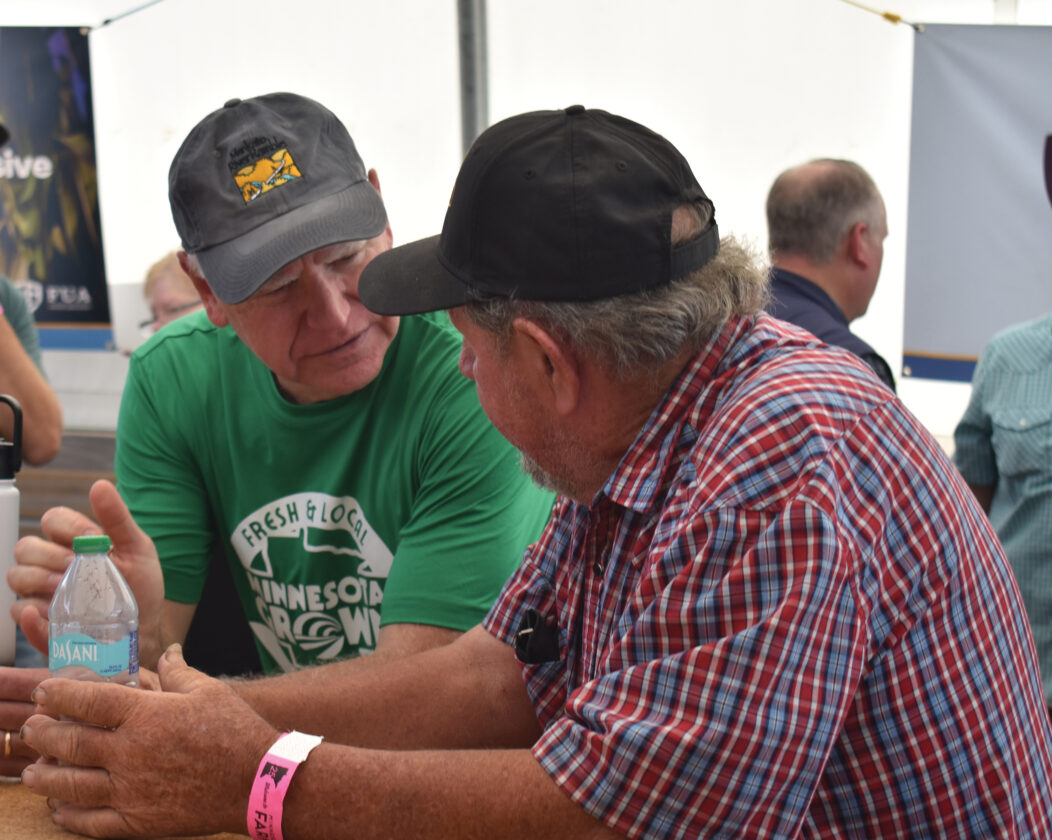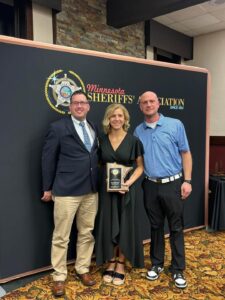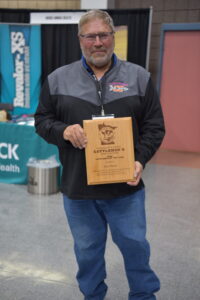‘No one wins a trade war’
Walz critical of Trump’s tariffs; says cuts to SNAP shrinks farm market

Photo by Clay Schuldt Gov. Tim Walz talks with Leavenworth resident Jerome Graf during Farmfest
GILFILLAN ESTATE — Minnesota Gov. Tim Walz returned to Farmfest Wednesday to discuss ag trade, cuts to SNAP and updated security for elected officials.
Walz has attended nearly every Farmfest for the last two decades, but missed last year after he was selected as the DFL nominee for vice president. Walz said he was excited to be back. He said ag producers at Farmfest are a reflection of how the state if faring.
“You get a feel for how things are going because it touches the (farmers) first,” Walz said.
In addition, he said Farmfest was a tradition for many folks, adding that it “needs to be” a tradition.
“Ag is still one of the cornerstones of our economy here in Minnesota,” he said. “More important than that, Minnesota is a leader not just nationally, but globally in feeding, clothing the world and innovation.”
Walz was encouraged that the Ag Bill remained one of the most bipartisan bills.
“It is one of the most collaborative and I think there is a deep understanding that economically, culturally and our position in the world is incumbent on Minnesota to understand how to feed an ever-growing world,” he said.
Tariffs were a top issue at Farmfest this year, but Walz said ag trade discussions had been going on for decades. Walz said trade deals were needed, but they needed to be fair. He did not believe the blanket tariffs placed on countries by the Trump administration were the correct solution.
“I don’t think it is the right way and I wouldn’t advise it, but at least these folks would know what to expect,” Walz said. “No one wins a trade war. Agriculture always loses a trade war.”
The governor argued for consistency in the tariffs to help ag producers plan for the future. Walz said farmers were not necessarily criticizing the president’s tariffs plan, but they were concerned about the uncertainty of it.
On tariffs Walz advised Trump to, “make up your mind to do and show us the positive results.”
The recent cuts to the Supplemental Nutrition Assistance Program (SNAP) were another concern going into Farmfest. Walz opposed the reduction of the program. He said the average SNAP recipient is under the age of 10 or over the age of 70 and mostly comes from Greater Minnesota.
“Remove the moral side of it, remove the politics of it, (SNAP) is a huge agricultural market,” Walz said. “Farmers get paid to sell products to the SNAP program. If the program shrinks, so does the market.”
Asked how rural school districts could provide services to students with the ongoing changes to the Department of Education, Walz said there needed to be bipartisan work to invest in education. He supported strengthening teacher training, but also teacher retention through pension updates. Walz also supported local innovation in education. He believed that in rural areas, there could be a cluster of school specializing in ag sciences, similar to the schools around Rochester that specialize in health care.
Asked about the two-year reimbursement gap facing rural nursing homes, Walz said the state could help reduce wait times, but noted that most of the problem lies with the federal government. He believes the recent federal cuts to Medicaid would force rural health care providers to raise rates or cut services.
The governor opposes the federal cuts to Medicaid. He acknowledged the program needed to reform, but believed the people receiving Medicaid coverage needed it.
“Seventy-five percent of Medicaid recipients are under the age of 12 and over the age of 70,” Walz said. “It is not the case that Medicaid is going to people who are able to work.”
Walz said the federal government needed to start listening to the directors of rural medical facilities and the problems they are facing.
Walz also addressed questions about the state Capitol security and security for state legislators following the shooting death of state representative Melissa Hortman and her husband in their home in June. Recently, Hennepin County commissioner Heather Edelson advised protesters not to gather outside elected officials’ homes.
Walz said Edelson made a valid point. He believes protesting outside of a citizen legislator’s home was a losing strategy that had the potential to traumatize the family of elected officials.
“I will protect your right to protest, I will protect your right to free speech, whether for or against me, but we have a public space for that at the Capitol, in the public square, we have the courthouse,” he said.
“I would just tell folks protesting, the surest way to hurt your cause is to show up at (legislators’) home.”
As for security at the Capitol in St. Paul, Walz said he reviewed Minnesota’s security compared to neighboring states. Before the shooting of Hortman on June 14, the Minnesota Capitol building had 14 open doors to the public. Most of the doors have since been closed, with access only granted through key cards.
Walz said this was an important change to be made, but said, “The Capitol is still open and still the people’s house.”




